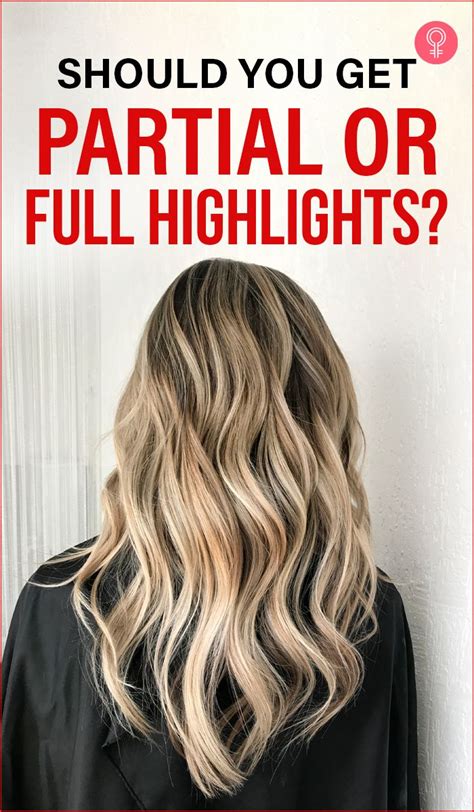Introduction
Hair contouring, the art of strategically placing highlights and lowlights to create the illusion of depth, dimension, and volume, has become increasingly popular. However, there are two distinct techniques used in hair contouring: full highlight and partial highlight. Understanding the differences between these two methods is crucial for achieving the desired results.

Full Highlight vs. Partial Highlight: A Comprehensive Comparison
Definition
- Full Highlight: Involves applying highlights to all of the hair strands, creating a more uniform and brighter overall look.
- Partial Highlight: Involves applying highlights to only a portion of the hair strands, resulting in a more subtle and natural-looking effect.
Coverage
- Full Highlight: Provides full coverage, creating a more noticeable transformation.
- Partial Highlight: Provides partial coverage, creating a more subtle change in hair color.
Brightness
- Full Highlight: Typically results in a brighter overall look due to the increased amount of highlighted strands.
- Partial Highlight: Provides a more natural-looking effect, as the highlighted strands blend in more seamlessly with the natural hair color.
Maintenance
- Full Highlight: Requires more frequent touch-ups (every 6-8 weeks) to maintain the desired brightness.
- Partial Highlight: Requires less frequent touch-ups (every 10-12 weeks) due to its more subtle nature.
Cost
- Full Highlight: Typically more expensive due to the higher cost of materials and longer application time.
- Partial Highlight: Less expensive due to the lower cost of materials and shorter application time.
Choosing the Right Technique for Your Needs
The choice between full highlight and partial highlight depends on several factors:
- Desired Effect: Full highlight for a bolder, more dramatic change; partial highlight for a more natural, subtle change.
- Hair Type: Thin hair may benefit from a full highlight to add volume and depth; thick hair can handle a partial highlight for a more natural effect.
- Time and Budget: Full highlight requires more time and money for maintenance; partial highlight is less time-consuming and more affordable.
- Lifestyle: Full highlight may be more cumbersome to maintain if you have a busy schedule; partial highlight is less time-consuming and more practical.
Benefits of Hair Contouring
- Creates the Illusion of Volume: Highlights and lowlights add depth and dimension, making hair appear fuller and thicker.
- Enhances Facial Features: Strategically placed highlights can frame the face, draw attention to the cheekbones, and brighten the eyes.
- Adds Movement and Interest: Highlights and lowlights create visual interest, making hair appear more dynamic and lively.
- Corrects Color Fading: Highlighting and lowlighting can help extend the lifespan of your hair color by blending away faded or brassy tones.
Why Partial Highlight Matters
While full highlight is often associated with bolder looks, partial highlight offers several unique advantages:
- Subtle and Natural Effect: Partial highlight mimics the natural variations in hair color, resulting in a more seamless and blended look.
- Versatile: Partial highlight can be customized to suit various hair types and preferences, from subtle balayage to more prominent face-framing highlights.
- Less Damage: Since only a portion of the hair is highlighted, partial highlight causes less damage compared to full highlight.
- Lower Maintenance Cost: Partial highlight requires less frequent touch-ups, which saves both time and money.
Applications and Innovations in Hair Contouring
The techniques of full highlight and partial highlight have inspired numerous innovations in hair coloring:
- Balayage: A freehand technique that creates subtle, natural-looking highlights by hand-painting color onto the hair.
- Babylights: Extremely fine, almost invisible highlights that add a soft, glimmering effect to the hair.
- Ombre: A technique that creates a gradual transition from dark roots to lighter ends, creating a sophisticated and edgy look.
- Reverse Ombre: A variation of ombre that reverses the color transition, starting with lighter roots and gradually blending into darker ends.
Conclusion
Full highlight and partial highlight offer distinct benefits and should be chosen based on individual preferences and hair goals. While full highlight provides a bold and dramatic transformation, partial highlight offers a more subtle and natural effect with lower maintenance costs. Understanding the differences between these two techniques empowers you to make informed decisions and achieve the perfect hair contouring results. Embrace the art of hair contouring and enhance your hairstyle with the perfect blend of highlights and lowlights.
